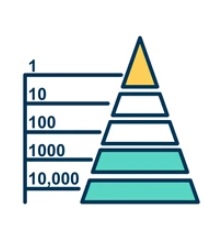INTRODUCTION

Energy flow in environment is the important function in the ecosystem. The storage of the energy in the ecosystem is based on two basic laws of thermodynamics. The first law of thermodynamics states that when energy is converted from one form into another, energy is neither created nor destroyed. The first law is also called the law of conservation of energy. The second law of thermodynamics shows that every transformation leads to a reduction in the free energy of the system. Energy conversion cannot be 100% complete.
The operation of an ecosystem follows the rules of thermodynamics, which govern the interactions of energy and matter in a system. First, we can account for the total energy input to an ecosystem in budgetary fashion. This is consistent with the first law of thermodynamics.
Energy may change form but not amount. But as the energy moves through an ecosystem, it does change form, ultimately to heat, which is not directly usable by the system. Thus the system tends to run down, dissipating its energy and losing its organized structure. This is the nature of the second law of thermodynamics, a tendency toward maximum disorganization of structures and maximum dissipation of usable energy.
GENERAL PRINCIPLES OF ENERGY FLOW
The behavior of energy in ecosystems is referred to as energy flow because energy transformations are directional , in contrast to the cyclical behavior of nutrients, The conversion of solar radiation to chemical energy by photosynthesis is the starting point of energy flow within ecosystems.
Solar energy is transformed from the radiant to the chemical form in photosynthesis and form the chemical to mechanical and heat forms in cellular metabolism. As energy travels through producers, consumers, and decomposers, these conversions and sequences are critical to the energetics of organisms and ecosystems.
Only about 1-5 percent energy of incident radiation, or 2-10 percent of PAR( Photosynthetically Active Radiation) is actually captured by the photosynthetic process ( gross primary productivity), and the remaining portion is dissipated. Since the simultaneously occurring respiratory processes are energy consuming and use up part of the photosyntheic gain, the net capture of energy ( net primary productivity ) is reduced to only0.8-4 percent of the incident total radiation, or 1.6-8 percent of PAR. Other trophic levels can only use the energy captured in producer (net productivity).
ENERGY FLOW MODEL
A simplified representation of energy flow through ecosystem has been made in figure in figure. The model attempts to recognize the various inputs and fates of energy. Two components of energy flow in the environment must be carefully considered.
1. First, energy travels in one direction, from producers to herbivores to carnivores; it cannot flow in the opposite direction.
2. Second, when trophic levels rise, the amount of energy flow reduces.
TROPHIC LEVELS

The trophic level of an organism refers to its place in the food chain. The word trophic derives from the Greek word meaning to food or feeding. It is simply a feeding level, as often represented in a food chain. Primary producers comprise the first trophic level, followed by primary consumers (herbivores), then secondary consumers (carnivores feeding on herbivores) and so on.
Omnivores eat both animals and plants. Further, except for some specialists, most carnivores dont limit their diet to organisms of only one trophic level.
FOOD CHAINS

A characteristic of an ecosystem of an ecosystem is the number and nature and nature of the species that occupy its various trophic levels. The connection between constituents of one trophic level and constituents of neighboring trophic levels might be depicted by an order of things. A natural order of things shows the development of energy through a framework by demonstrating the way of food from a producers to a last consumer. As a rule, orders of things have 3 to 5 trophic connections with 15 to 20 species. The length of food chain also may shorter food chain than a temperate or tropical one.
There are two main hypotheses. One of them, the energy hypothesis, suggests that the length of the food chain is limited by the inefficiencies of energy transfer along the chain. As we know, only about 10% of the energy stored in organic matter at each trophic level is converted to organic matter at the next nutrient stage ( trophic level).
The second hypothesis, the dynamic stability hypothesis, proposes that long food chains are less stable than short chains. Population fluctuations at lower nutrient levels were amplified at higher levels, potentially causing local extinctions of higher predators. This hypothesis predicts that food chains should be shorter in unpredictable environments. Most of the available data support the energy hypothesis.
TYPES OF FOOD CHAINS
GRAZING FOOD CHAIN
The grazing food chain gets its energy directly from the sun. The grazing food chain begins with the primary producer. Primary consumers or herbivores form the second link in the grazing food chain. They get their energy from the consumption of primary producers. Secondary consumers or primary carnivores, the third link in the chain, get their energy from eating herbivores. A tertiary consumer or secondary carnivore is an animal that obtains organic energy from eating a primary carnivore.
DETRITUS FOOD CHAINS
The detritus food chain begins with dead organic matter, an important source of energy. A large amount of organic matter is contributed by the death of plant’s parts, animals and their excretion products. These types of food chains are present in all ecosystems. Various species of microscopic fungi, bacteria and other saprophytes play a prominent role in decomposing organic matter to obtain energy needed of their survival and growth.
The food chain of detritus is connected to the grazing food chain. Most natural ecosystems have both grazing and detritus form of food chain.
FOOD WEB

In most cases, such a simple food chain is an oversimplified version of the reality of food relations. Instead, there are often multiple interconnected paths and many different types associated with each nutritional stage. These complex paths are more like the web than a simple chain, known as the food web. So, a food web is a pictorial representation of the feeding relationship between organisms in an ecosystem and consists of interlocking food chains.
CONCLUSION
The sun is the ultimate source of energy. Ecosystem is functional units in which energy flows very effectively between abiotic components. The flow of energy in an ecosystem is always one-way. The energy of an ecosystem is never destroyed, but it is transformed from one form to another. Only 10% of the energy goes to the next nutritional stage (trophic level). Since the sun is the only source of renewable energy available at higher nutritional stages, the energy of the sun is available to organisms at higher nutritional stages. When food chains and web links are removed, there is no efficient flow of energy.
Discover more from ZOOLOGYTALKS
Subscribe to get the latest posts sent to your email.

